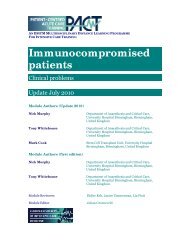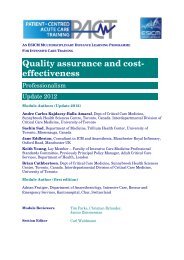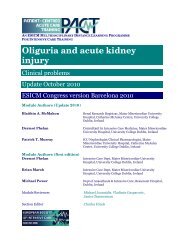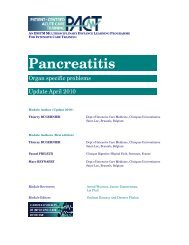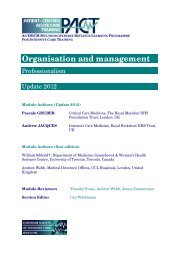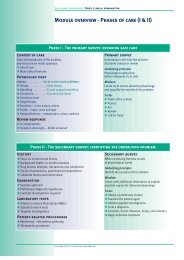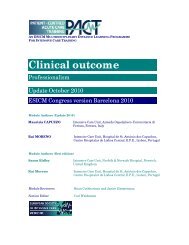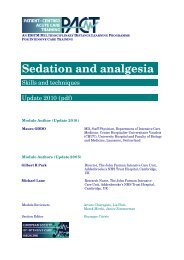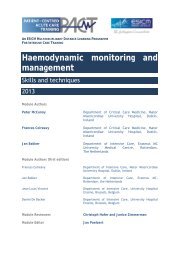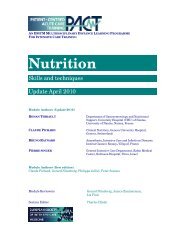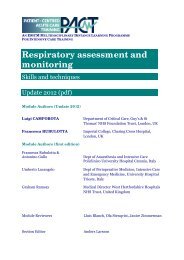Burns injury - PACT - ESICM
Burns injury - PACT - ESICM
Burns injury - PACT - ESICM
You also want an ePaper? Increase the reach of your titles
YUMPU automatically turns print PDFs into web optimized ePapers that Google loves.
2/ HOSPITAL ADMISSION – THE FIRST 24 HOURS<br />
Initial hospital management<br />
When the patient is admitted to hospital, the primary (ABC) survey is re-checked and<br />
a secondary survey is performed. Emergency medicine physicians/intensivists,<br />
surgeons, anaesthesiologists and nurses work together to provide optimum initial<br />
care and to chart the <strong>injury</strong> and the condition of the patient. Clothes and bandages<br />
are removed, and the wounds are washed with tap water and soap or with sterile<br />
saline [Video of wound cleaning in interactive version]. A central venous catheter<br />
(preferred in adults with burns >20 %TBSA and in children with burns >15 %TBSA<br />
depending on hospital practice), arterial catheter and urinary catheter are positioned<br />
after the cleaning (preferably catheters placed before cleaning should be removed).<br />
Secure all lines carefully. Bloods for haemoglobin, electrolytes, creatinine,<br />
creatinine kinase, liver function tests and blood gas analyses are obtained and many<br />
units take swabs for microbiology, and blood cultures from the outset. It is important<br />
that the temperature in the admittance area be adjusted to above 30 C to prevent<br />
hypothermia.<br />
Burn centre referral criteria<br />
Management of patients with large burns (Table in interactive version) is resource<br />
demanding. A team of intensivists, surgeons, anaesthesiologists, dedicated ICU<br />
nurses, physiotherapists and social workers are involved in the collaborative<br />
management of these patients to achieve the best cosmetic and functional result. It<br />
has long been demonstrated that patients benefit from a specialised burn centre if<br />
certain criteria are present. The patient should then be referred as soon as possible<br />
to such a centre.<br />
The ABA has defined transfer criteria for burn patients:<br />
Second degree burns >10% TBSA<br />
Third degree burns<br />
<strong>Burns</strong> that involves face, hands, feet, genitalia, perineum and major joints<br />
Chemical burns<br />
Electrical burns including lightening injuries<br />
Any burn with concomitant trauma in which the burn injuries pose the<br />
greatest risk to the patient<br />
Inhalation <strong>injury</strong><br />
Patients with pre-existing medical disorders that could complicate<br />
management, prolong recovery or affect mortality<br />
Hospitals without qualified personnel or equipment for care of critically<br />
burned children.<br />
Herndon DN, editor. Total Burn Care. 3rd edition. Edinburgh: Saunders-Elsevier;<br />
2007. ISBN 978-1416032748<br />
6




